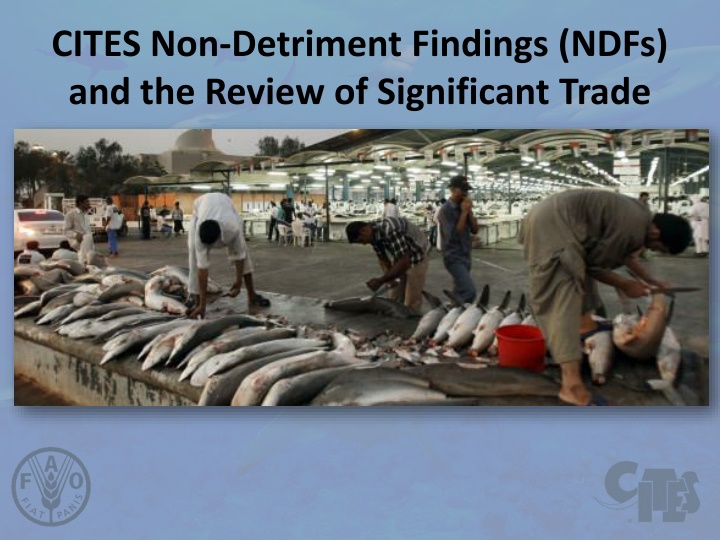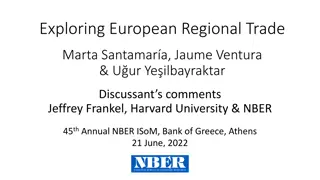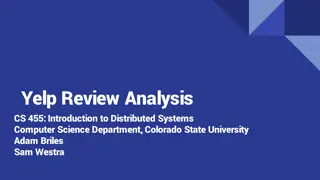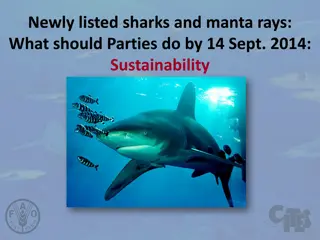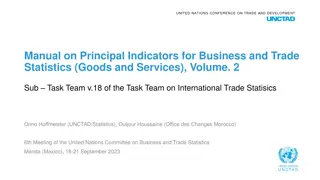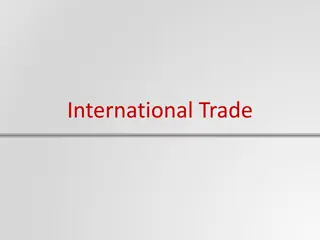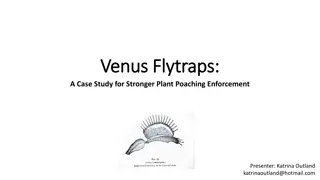Insights into CITES Non-Detriment Findings and Trade Reviews
Understanding the core principles of CITES Article IV, which governs international trade in endangered species, is crucial for ensuring sustainability. The process involves Non-Detriment Findings (NDFs), export permits, and the significant trade review mechanism to prevent unsustainable trade practices. If corrective actions are timely, it can help conserve species listed in Appendix-II from shifting to Appendix-I due to trade threats.
Download Presentation

Please find below an Image/Link to download the presentation.
The content on the website is provided AS IS for your information and personal use only. It may not be sold, licensed, or shared on other websites without obtaining consent from the author.If you encounter any issues during the download, it is possible that the publisher has removed the file from their server.
You are allowed to download the files provided on this website for personal or commercial use, subject to the condition that they are used lawfully. All files are the property of their respective owners.
The content on the website is provided AS IS for your information and personal use only. It may not be sold, licensed, or shared on other websites without obtaining consent from the author.
E N D
Presentation Transcript
CITES Non-Detriment Findings (NDFs) and the Review of Significant Trade http://i.huffpost.com/gen/823290/thumbs/r-PERSIAN-GULF-SHARK-FINNING-large570.jpg?6
Article IV: the heart of CITES Commercial international trade in Appendix-II species may take place, but only if the Management Authority of the exporting State issues an export permit No such permits should be issued unless the Scientific Authority of the exporting State advises that the export which is to take place will not be detrimental to the survival of the species
Article IV: the heart of CITES Authorized trade is likely to take place at unsustainable levels if: there is no adequately functioning mechanism for the Scientific Authority to advise on safe levels of trade, or non-detriment findings are incorrect or not made, or the Management Authority issues export permits contrary to the advice of the Scientific Authority, or no adequate monitoring takes place
Include in Appendix I If a regime of unsustainable trade in an Appendix-II species is not noted and rectified in the monitoring process expected of the Scientific Authority, then ultimately a proposal may be formulated by other Parties for the inclusion of the species in Appendix I If accepted by the Parties, then the problem will finally be addressed by the prohibition of all commercial trade
The Significant Trade Review process The Significant Trade Review process, if implemented correctly, acts as a safety net by ensuring that species do not decline because of trade while they are listed in Appendix II If corrective measures are taken in a timely manner, then there should be a reduction in the number of animal and plant species that need to be transferred from Appendix II to Appendix I because they are endangered by international trade 5
The Significant Trade Review process The process is conducted by the Animals and Plants Committees The Committees have a mandate to identify Appendix-II species subject to significant levels of trade that are of immediate concern They consult with range States, the CITES Secretariat and experts to review and assess relevant biological and trade information If necessary, they make recommendations for action by range States where exports are problematic, with time limits for implementation
The Significant Trade Review process Resolution Conf. 12.8 (Rev. CoP13) also spells out when each of the participants in the process has a particular task to carry out The Review is a process to ensure that provisions of Article IV are being met, and trade is sustainable and not detrimental to the survival of the species
A 3-stage process The Significant Trade Review process for Appendix-II listed species comprises three stages: Stage 1 - Selection Compilation of a list of species traded at significant levels that are of immediate concern Stage 2 - Review Consultation and review to identify possible problems in the implementation of Article IV for selected species Stage 3 - Actions Processes to improve the implementation of Article IV where necessary
Points where species could exit process The process Consultation Secretariat Species selection AC/PC AC/PC first review Recommendations AC/PC implementation reviewed Secretariat + Chair AC/PC review and categorization Research Secretariat Recommendations AC/PC implementation reviewed Species of urgent concern Species of possible concern Recategorization AC/PC SC action 9
Benefits of the Significant Trade Review Reduces tendency of importing countries to apply unilateral stricter domestic measures (such as import bans or externally-imposed export quotas for range States) Eliminates risk of transfer to Appendix-I Exporting countries may receive external support to undertake field studies and develop technical and administrative capacity necessary to implement the requirements of Article IV 10
Thank you for your attention! CITES and FAO working for legal, sustainable and traceable international trade in sharks and manta rays, supported by the European Union 11
